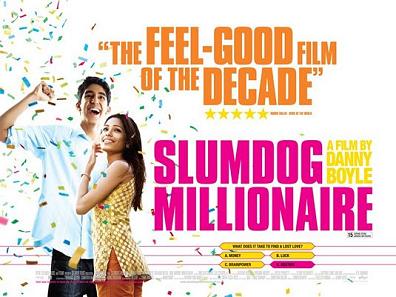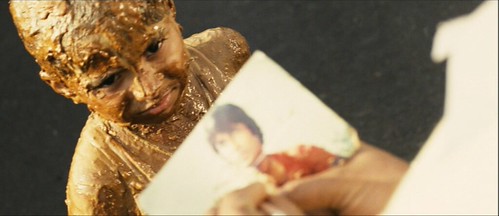
Slumdog Millionaire is cotton candy; it's junk food because it tastes good, but dissolves fast. Thematically and emotionally, it offers pseudo-profundities that only seem really deep. Its declarations of fate, for instance, are no deeper than those found in the ultra-consumerist anime Yu-gi-oh!. It provides us with nothing profound or troubling to think about, instead indulging the audience in what it wants to see, rather than what it ought to see. It is an instance of trash revered as art; audiences and critics fawn over it because they don’t know the difference—or because they can't find anything better. Slumdog Millionaire is no more artful than Armageddon, and the Bruce Willis picture is arguably a more genuine and honest work. The thing that irks me about Slumdog is its aspirations to be more than it is and the attention that’s lavished on it as if it’s a work of truth and brilliance. It is not art, it has nothing especially challenging or interesting to say, and frankly, it’s an emotional dud.
Slumdog is so dependent on its gimmick that if we were to remove it, we’d see how banal the movie really is. The Who Wants to be a Millionaire angle is little more than a novelty. The indictment of westernization is slight and innocuous; the let’s-see-how-he-knows-the-answer business is contrived and shallow. What’s more, that silly question at the beginning and the answer at the end merely make a gimmick out of the gimmick; it’s like a parody of parody. Such a juvenile declaration of fate deprives the audience of anything to think about. “It is written.” No questions, please.
Such a message not only has little basis in reality but flattens the characters in the story. Instead of representing real people with real thoughts, feelings, and aspirations, these characters become one dimensional pawns used by the movie to appeal to the mass audience and their wishes. The movie's been called a love story "above all" but does it even do a good job of that? We're frequently shown our star-crossed lovers Jamal and Latika separated or being separated by outside forces, so it’s no wonder we’re getting all anxious to see them [finally] be together. But they spend so much time apart, I begin wondering what Jamal even knows about Latika. In pretty much their only conversation, they dream about what they’ll be able to buy (“weddings, government things, big parties…Big money”). Their concerns are entirely juvenile and materialistic, but the real problem is they don’t grow up. Especially Jamal. I remember the inspector saying to him: “all you think about is money.” That, and Latika. So it’s money, money, Latika, money, and Latika.
Jamal is such a banal character that I wonder how people could take a liking to him. He’s not the one making things happen; things are happening around him and he either lucks out or not. That’s the whole premise of the movie and repeatedly Boyle provides us with imagery that shows Jamal as the helpless but spirited kid from Bombay. Early on, we see alternations between Jamal on the show with the Indian version of Luis Guzman and being tortured by the host’s private investigator. The torture scenes hold no power to shock us, just as the shaky camera and dutch angles galore don’t have the impact they should. This is because Boyle releases his tension in little bursts, thus desensitizing us with excess.
Rather than see a single spike of violence, we get it diffused across a scene; rather than a single, jarring cut to a dutch angle, Boyle cuts, cuts, and cuts from one dutch angle to another—I swear it’s like a seesaw. Such effects seem effective, but only intellectually so. This is the problem with the shot-by-shot analysis I’ve grown so weary of; it’s academically true, but we lose the flavor and feel of the picture when we start assigning meaning to individual shots and cuts. In other words, we think about what we should feel without actually feeling it. Boyle probably saw Do the Right Thing or The Third Man in film school and decided dutch angles would be good for chaos/change/character development/tension/emotion. The thing is, he uses it for every one of those things to the point where the shot no longer has the impact it once did. These effects would be forgivable if Jamal weren’t such a shallow, underdeveloped character.
The movie is so intent on dazzling the audience that our understanding of its characters suffers. What do we know about Jamal? Well, early on we see him incapacitated, with the interrogator stringing him up, slapping him around, and running electricity through his toes. Dev Patel excels at that I-just-got-slapped expression but it’s about the only one he can do. We then see a young Jamal about to catch a cricket ball but then getting blown over by an airplane’s gust. Such images peg him as powerless; he is subject to whatever fate the heavens have in store. “It is written” the movie concludes, but by whom? Is it God? Not likely, since the movie barely carries any religious weight to it. The only person actually seen praying is Salim, and he’s hardly given any sort of proper redemption. He dies in a bathtub full of money, having “redeemed” himself by helping Latika. Yet this final act—perhaps the only humanist one in the movie—is completely dropped by the end as Dev Patel and Freida Pinto lead into a Bollywood dance number.
It’s like the movie wants to show you terrible things, but then wants you to forget how badly they made you feel. Yes, the poor, poor [bourgeois] audience needs some consolation for the frightening realities they’ve just been exposed to, so here’s a Bollywood dance number. Salim, who is probably the most human and realistic character in the movie isn’t given the time he deserves. He’s Jamal’s brother, but his death is glossed over by 20 million ruppees, [finally] meeting at the train station, and breaking out into an exhuberant dance number. The movie wants to give its audience an endless respite from the horrors it shows, but it is so intent on—or maybe obligated to—showing those horrors in the first place. Everything it does is designed to defuse terrible realities. A child covered in shit isn’t meant to garner our sympathies but is there for comic relief. Indeed, the audience I saw it with roared with laughter at a young Jamal covered in excrement. The scene is as absurd as the Who Wants to be a Millionaire device and is pure novelty; it’s no more than exploitation.
That Slumdog has been showered with awards is a sign that Kael was right when she said: “When we championed trash culture, who knew it would become the only culture.” Slumdog Millionaire is little more than wish-fulfillment, but what makes it so detestable is it obviously aspires to something greater. It reminds me of that Simpsons episode where the producers of Itchy and Scratchy are trying to figure out what their audience wants: “So you want a realistic, down-to-earth show that’s completely off the wall and swarming with magic robots?” Slumdog wants to show awareness to the reality of slum life. It wants to be a compelling love story, it wants to make its audience happy but uncomfortable, and it wants to criticize westernization while embracing it all the same. It’s a movie that thrives in the politically correct milieu we have today and is just as wishy-washy. It ends up doing everything half-assed; it’s like the [often liberal] person who wants to be politically and globally “aware” and knowing, and achieves that by a skim of the newspaper headlines.
Much of my argument is dependent on how Slumdog Millionaire has been received, which is usually frowned upon. But to evaluate such a movie—which is so beloved by critics and audiences alike—in a vacuum forgoes one of the main functions of the movie medium. Perhaps more than any other, movies are a public medium. Public perception, while not everything, is integral to evaluating a movie; how a work is perceived indicates its merit. To simply blame the audience for misinterpretation precludes artists from reproach and rejects the responsibilities they have. In the end, however, it’s a two-way street. Audiences are to blame for idolizing and enjoying a movie that turns shit-covered children into a laughing stock, and the artists are to blame for feeding them such wishy-washy, pandering “art.”

No comments:
Post a Comment